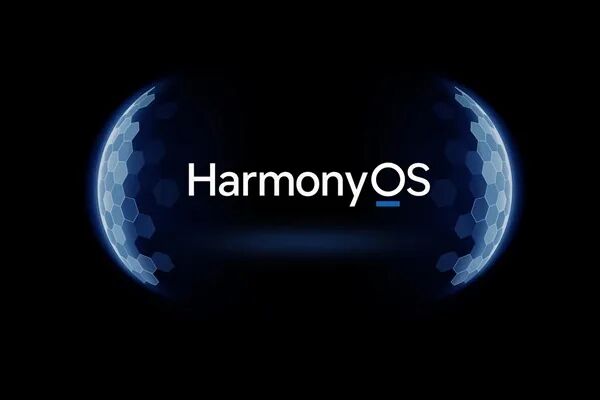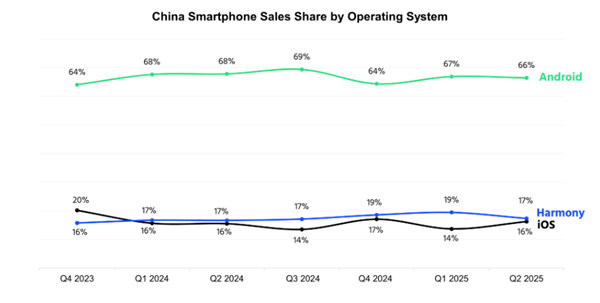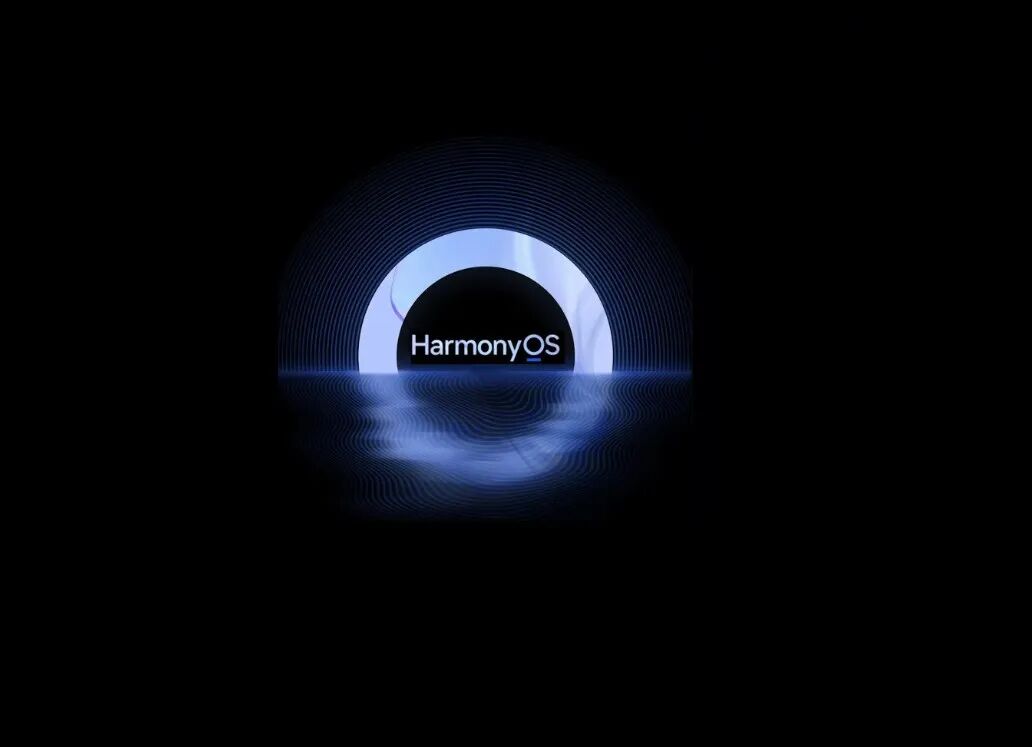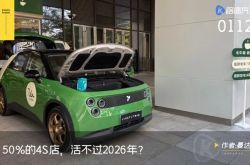Huawei Hongmeng Truly Cements Its Position! Outpacing Apple for Six Straight Quarters
![]() 09/24 2025
09/24 2025
![]() 548
548

Text by Wang Miao, Art Design by Gu Qingqing, Produced by Networld
On September 22, market research firm CounterPoint Research unveiled a report indicating that from the first quarter of 2024 to the second quarter of 2025, Huawei's Hongmeng system has consistently outshone Apple's iOS in the Chinese market for six consecutive quarters, firmly cementing its status as the second-largest smartphone operating system in China.
This accomplishment is not a sudden spike but rather the inevitable outcome of the Hongmeng ecosystem's long-term endeavors. It's crucial to note that iOS has enjoyed a deeply entrenched presence in the Chinese market for years, boasting a sizable and devoted user base. Surpassing it in market share is an incredibly daunting task. Yet, Hongmeng has not only achieved this feat but also maintained its lead for six straight quarters.

Globally, Android still reigns supreme with a 79% market share, followed by iOS at 17%, and Hongmeng at 4%, ranking third.
Nevertheless, the performance in the Chinese market alone is sufficient to showcase the potential of this domestic operating system, which is breaking the duopoly and forging its own unique path to growth.
01 Blockbuster Products Fuel Ecosystem Expansion
The cornerstone of Hongmeng's success lies in the resurgence of Huawei's mobile phone business.
According to the latest IDC report, in the second quarter of this year, Huawei shipped 12.5 million smartphones, capturing an 18.1% market share and surpassing brands like Apple and Xiaomi to claim the top spot. This directly provided Hongmeng with a vast user base.
Huawei's Nova series has been a steadfast pillar for Hongmeng. Targeting the youth demographic, this series has won over its core consumer base with its aesthetic design and high cost-effectiveness. In February 2025, the nova13 series ranked fourth in sales in the Chinese market, being the sole Huawei model to make it to the top five.
Folding screen phones like the Huawei Pura X have also garnered significant consumer attention with their innovative designs. Robust smartphone sales naturally drive up the system's market share.

However, smartphones alone are not the be-all and end-all. From the outset, Hongmeng's ambition extended beyond just being a mobile operating system; it aimed to seamlessly connect smartphones, tablets, computers, watches, TVs, and a myriad of other devices.
Currently, many Huawei smartphone users also own other Huawei products such as tablets and watches. Data reveals that 69% of Huawei smartphone users have bound at least one other Hongmeng ecosystem device.
This "1+8+N" full-scenario experience makes users less likely to abandon the Hongmeng ecosystem once they've entered it, thanks to the seamless device collaboration. This stickiness is a pivotal reason why Hongmeng has consistently outperformed iOS.
02 Comprehensive Coverage: From National Apps to Government and Enterprise Scenarios
If hardware forms the skeleton, then the application ecosystem is the lifeblood of Hongmeng. The competition among operating systems is essentially a battle of ecosystems. Without rich application support, even the most fluid system cannot retain users. Hongmeng has achieved in just a few years what others have taken over a decade to build.
The entry of top-tier applications has instilled users with direct confidence. In March this year, Alibaba announced the development of Hongmeng native applications for 11 of its popular apps, including Xianyu, Fliggy, and Hema.
Combined with previous initiatives from Taobao, Gaode Maps, DingTalk, and others, nearly all of Alibaba's core applications have joined the Hongmeng family.
This sends a powerful signal: mainstream application developers now view Hongmeng as a critical market to tap into.

Notably, earlier this year, the CCTV News app also announced the development of its Hongmeng native application. The involvement of a national mainstream media outlet not only enriches Hongmeng's content but also provides significant confidence.
The enthusiastic participation of developers has also fueled the ecosystem's growth. Currently, Huawei has launched a RMB 1 billion "Tiangong Plan" to support AI ecosystem innovation and announced an investment of RMB 15 billion in ecosystem development, equipped with 1,500 PFLOPS of open-source community computing power and a development support team of 15,000.
These investments have yielded substantial results: the number of registered developers continues to climb, with over 130 million lines of open-source Hongmeng code and more than 1,300 compatible hardware and software products.
For developers, Hongmeng's "develop once, deploy across multiple devices" feature significantly reduces costs. Moreover, Hongmeng developers report higher income levels, with nearly twice the proportion exceeding expected earnings compared to developers on other platforms. This financial incentive attracts more developers to join the fray.
03 From "Usable" to "User-Friendly" Experience
Ultimately, Hongmeng's ability to retain users and attract partners stems from its technological prowess. Rather than simply imitating existing systems, Hongmeng is built on a new architecture designed for the era of the Internet of Everything, offering generational advantages in user experience.
The distributed architecture is Hongmeng's core technological hallmark, breaking down the "information silos" between devices.
While this concept may sound technical, it essentially enables different devices—such as smartphones, tablets, computers, watches, and even cars—to work together seamlessly as if they were a single device. This full-scenario smart experience is what sets Hongmeng apart from other systems.

The deep integration of AI capabilities has transformed Hongmeng from a "passive responder" to a "proactive service provider." Hongmeng's "Xiaoyi Task Space" is no longer just a voice assistant but a versatile "project manager."
When a user says, "I'm going on a trip during National Day," it can automatically coordinate multiple apps like maps, bookings, and weather to generate a complete itinerary including schedules, hotels, and routes.
For market research reports, it can access databases, compile information, and generate a comprehensive report or even a PPT within 20 minutes.
This ability to dissect and schedule complex tasks has revolutionized traditional human-computer interaction.
The system's autonomy and controllability address user security concerns. Previous operating systems were often based on Unix or Linux kernels. However, after Hongmeng 5, the system fully switched to a self-developed kernel, removing Linux and AOSP (Android Open Source Project) code to achieve a truly "pure-blood Hongmeng."
User feedback continues to drive system optimization. Hongmeng has received over 10 million user suggestions, with more than 96% promptly addressed. These meticulous refinements have transformed Hongmeng from "usable" to "user-friendly" and even "beloved."
Conclusion: Hongmeng's Rise Signals a Tripartite Market Future
Hongmeng's six consecutive quarters of outperforming iOS in the Chinese market comprehensively validates the progress of this domestic operating system from technological breakthroughs to ecosystem maturity.
In the past, Android and iOS were considered unshakable. However, Hongmeng has proven that by addressing user needs, adhering to technological innovation, and building an open ecosystem, new operating systems can carve out their own space for survival and growth.
From young users of the Nova series to office workers in government systems, and from smartphones to folding screens and smart home devices, Hongmeng has penetrated diverse demographics and scenarios, forming a vibrant ecosystem.
Of course, Hongmeng's journey is far from over. With a global market share of 4%, it still lags behind Android and iOS. However, it has already achieved commercial use in over 50 countries, with analysts predicting its global share could exceed 15% in the next three years.
Huawei's investment of RMB 15 billion in ecosystem development and RMB 1 billion in the "Tiangong Plan," along with a growing developer community, are paving the way for this goal.
From a broader perspective, Hongmeng's growth reflects the collaborative innovation of China's tech industry. It is no longer a "solo performance" by Huawei but a "collective charge" involving hardware manufacturers, app developers, and government agencies.
This six-quarter lead is just the beginning. As HarmonyOS NEXT continues to evolve and expand into overseas markets, a global operating system landscape divided among three major players may soon become a reality.






